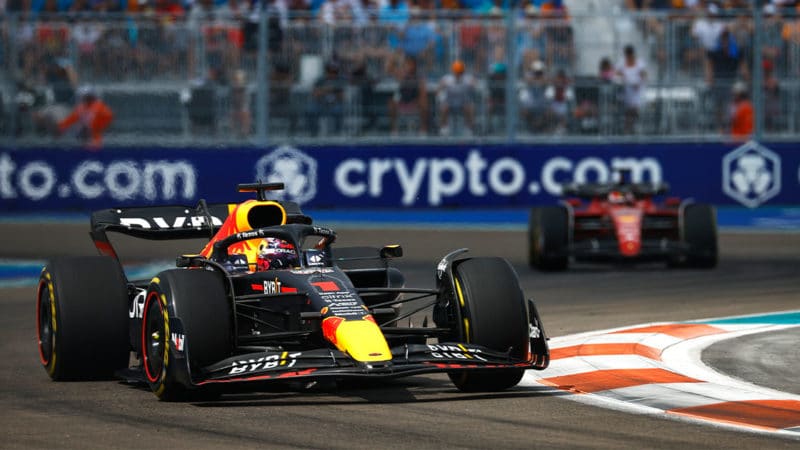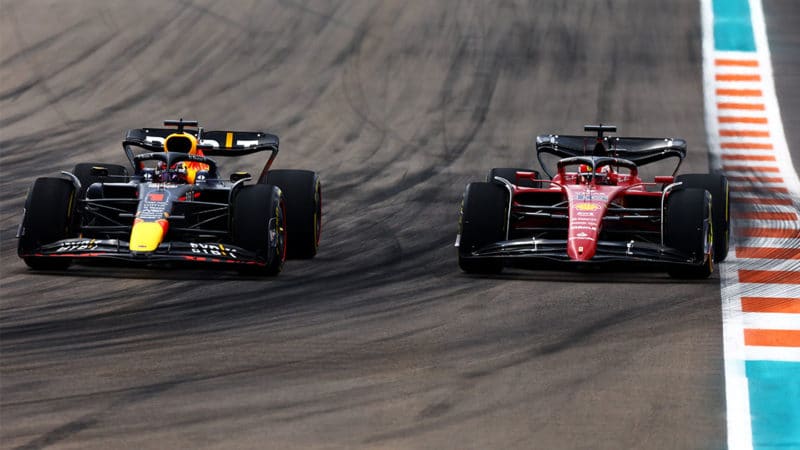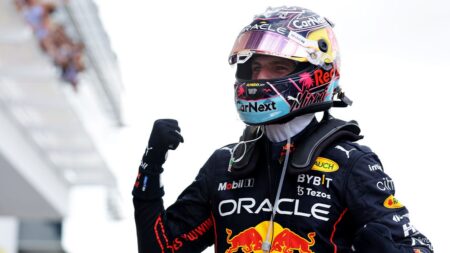Sainz was hanging on not far behind his team mate, always just out of reach of Sergio Perez. Valtteri Bottas’s Alfa Romeo led the best of the rest class, staying comfortably ahead of Lewis Hamilton’s Mercedes.
Verstappen pulled out enough time that Red Bull didn’t need to immediately respond when Ferrari brought Leclerc in for his hard compound tyres on the 24th of the 57 laps. Even waiting another couple of laps before getting into his fresh hard tyres, Verstappen was still over 7sec clear, 0.8sec of which had been won by Red Bull’s faster pit stop.
That seemed to be game over. The interest was now surely whether Perez could wrest third from Sainz. Carlos suffered a front-right delay at his stop which would probably have allowed Perez to have jumped him – except the second Red Bull had lost 5sec to a sensor failure which had drastically reduced power just as he’d been within DRS reach. It came back to life with some switch changes, albeit around 25bhp down – but the opportunity of passing Sainz had slipped by.
Sainz was increasingly troubled by a sore neck from his Friday crash as the race went on and with Perez slowed by his down-on-power engine the lead two pulled away. On the hard tyres the Ferrari had no problems and Leclerc was every bit as quick as Verstappen, the pair trading fastest laps, but with Max retaining his earlier cushion.
The victory threatened

Hamilton was once again foiled by a late safety car
Grand Prix Photo
The collision between Pierre Gasly and Lando Norris (as the former rejoined the track after running wide at Turn 8) came at a potentially inopportune time for Verstappen and Red Bull. A VSC changed to a full safety car just as he had passed the pit entry road – giving Leclerc (who was almost half-a-minute clear of Perez) the opportunity of getting onto new tyres and rejoining in the safety car queue right in Verstappen’s wheel-tracks (if Ferrari had also pitted Sainz).
But Ferrari stayed out, much to Red Bull’s relief. It had only a set of fresh hard tyres – which would have taken an age to warm up. Ferrari preferred to bet on its car’s faster warm-up of the existing tyres to take the challenge to Verstappen. Which is exactly how it panned out.
If only DRS had been available immediately, Leclerc could probably have retaken the lead. As it was, he was all over Verstappen but the Red Bull was just too fast at the end of the straights. By the time DRS was enabled after two laps, Verstappen’s tyres were up to temperature and the crisis was over.
Perez was brought in for fresh mediums under the safety car and used these to attack Sainz but the latter did well to repel him to the flag. George Russell – who had qualified his bouncing Mercedes only 12th and started on the hard – was able to run long enough to pit under the safety car for his only stop. That put him on team-mate Hamilton’s tail rather than 15-17sec behind – and on fresher tyres. Inevitably, he was able to pass – but not before they’d both passed Bottas’s Alfa after the latter ran wide on cold tyres shortly after the restart.
Without the safety car, Hamilton would have been the leading Mercedes, albeit likely beaten by Bottas – and around a minute adrift of the victorious Verstappen.



